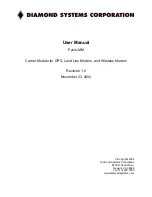
PS150/CH150 12 V Charging Regulators
2
completely unloaded if full-charge is reached. While this unloading of the
charging source is acceptable for solar panels, AC/AC transformers and
AC/DC converters, it is undesirable for wind turbines because of the resulting
free spinning when unloaded. Consequently, series charging regulators,
including the PS150/CH150, should not be used to regulate the output of wind
turbines without the inclusion of a way to load the turbine when the batteries
require little or no charging current.
The PS150/CH150 chargers have several safety features intended to protect the
charging source, battery, charger, and load devices. Both the
SOLAR – G
and
CHARGE – CHARGE
input terminals incorporate hardware current limits
and polarity reversal protection. There is a 5 Amp slow-blow fuse in series
with the
CHARGE – CHARGE
inputs in the event of a catastrophic AC/AC
or AC/DC charging source failure. If the 5 Amp load is sustained long enough,
the device will open permanently. There is a 4.65 A self-resetting circuit
breaker in series with the
12 V
output terminals of the charger in the event of
an output load fault. The PS150/CH150 incorporate battery reversal protection,
which is catastrophic for most chargers. ESD and surge protection are
incorporated on all inputs and outputs of the PS150/CH150.
2. Precautions and Tips
Risk of electric shock. Use only in a dry
location, such as indoors or in a weather-
sealed enclosure.
Risk of fire or electric shock. Do not inter-
connect output terminals.
Permanent damage to rechargeable cells may result if
discharged below 10.5 V.
Under normal charging conditions with sealed VRLA batteries, hydrogen and
oxygen gasses are produced in relatively small quantities, most of which later
recombines back into water. Aggressive overcharging produces excess
hydrogen and oxygen gasses, resulting in gas venting by means of a pressure
activated valve. Hydrogen gas emitted from VRLA batteries must not be
allowed to accumulate, as it could form an explosive mixture. Fortunately,
hydrogen gas is difficult to contain in anything but a metal or glass enclosure.
Never put VRLA batteries in an enclosure that
does not allow emitted hydrogen gas to be
dispersed.
VRLA batteries are capable of providing high surge currents. The 12 V output
terminals of the PS150/CH150 are fused with a 4.65 A self-resettable circuit
breaker, but there is no fusing for inadvertent bridging of the battery terminals.
Accidental shorting of battery terminals by metallic objects, such as
DANGER
DANGER
WARNING
DANGER






































